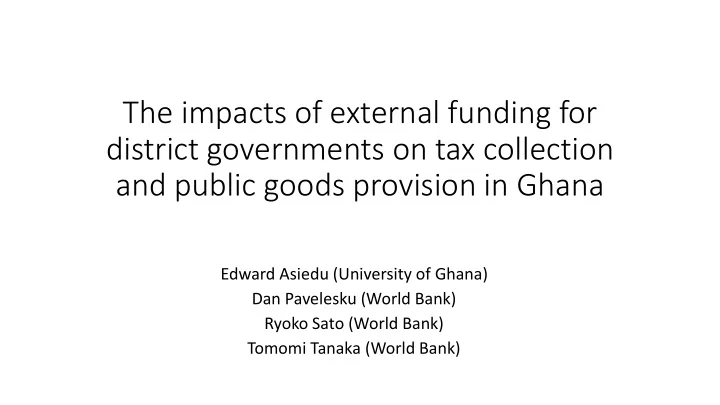

The impacts of external funding for district governments on tax collection and public goods provision in Ghana Edward Asiedu (University of Ghana) Dan Pavelesku (World Bank) Ryoko Sato (World Bank) Tomomi Tanaka (World Bank)
Research Questions 1) Do external revenues crowd in or crowd out internal revenues? Do the effects depend on poverty rates of districts? 2) When revenues rise, which category of expenditures do district governments increase? 3) Does an growth in revenues/expenditures lead to increased provisions of public goods?
Summary Statistics - Revenues • Poor districts: smaller Revenues in 1995 and 2007 revenues. 3000 2500 • Gap between poor & rich districts: 2000 • Narrowed for External revenue. 1500 • Widened for Internal revenue. 1000 • Rich districts increased internal 500 revenue and became less dependent on external 0 revenue compared with poor 1995 2007 1995 2007 districts. External Revenue Internal Revenue Richest Poorest
Summary Statistics - Expenditure • Poor districts: smaller Expenditure over time expenditure. 1000 900 • William (2016): 29% of capital 800 expenditure is wasted; many 700 district projects are never 600 completed. 500 Capital expenditure declined, 400 esp in poor districts. 300 200 • Personal expenditure 100 increased, esp in poor districts. 0 1995 2007 1995 2007 1995 2007 1995 2007 1995 2007 1995 2007 Could be due to ghost workers Personal Transport General Repairs Misc Capital in the public sector. Richest Poorest
Identification Strategy for Impacts of external revenue change on internal revenue collection • Specification (Mogues and Benin, 2012; growth model) ∆[𝑚𝑜(𝐽𝐻𝐺 𝑗𝑢 )] = ln(𝐹𝑌𝑈 𝑗𝑢−1 )𝜀 + ln(𝐹𝑌𝑄 𝑗𝑢−1 )𝛿 + ∆𝑚𝑜(𝐽𝐻𝐺 𝑗𝑢−1 )𝜚 + 𝑆 𝑗 𝜇 + 𝐸 𝑢 𝜐 + 𝛽 + 𝜃 𝑗 + 𝜁 𝑗𝑢 • ∆[𝑚𝑜(𝐽𝐻𝐺 𝑗𝑢 )] : change in the log of internal revenue (IGF) from the time t-1 to the time t • 𝐹𝑌𝑈 𝑗𝑢−1 : lagged external revenues for district i • 𝐹𝑌𝑄 𝑗𝑢−1 : vector of lagged expenditures at time t-1 • 𝐸 𝑢 : time effects • η i + ε it : error terms
Impacts of external revenue change on internal revenue collection Effects of Lagged External Revenues on Internal Revenues • The increased external revenue leads to reduced internal revenue from market 0 -0.01 fees (from market traders) & business -0.02 licenses: crowding-out -0.03 -0.04 -0.05 -0.06 by Poverty Rate • In the poorest districts: collection of 0 internal revenue does not respond to Non-poorest Poorest -0.05 the increase in external revenue -0.1 -0.15 -0.2 Rates Lands Fees Licenses Rental Invest Misc. IGF Total
Impacts of revenue change on expenditures Effects of Change in Revenue on Change in Expenditure Increased revenues raised expenditure in 100 50 • capital expenditure (could be 0 wasteful; William, 2016) Internal Revenue External Revenue Personal Transport General Repairs Misc Capital by Poverty Rate • Personnel expenditure (could be 300 wasteful due to a large number of 200 ghost workers in the public sector) 100 0 Internal External Internal External Revenue Revenue Revenue Revenue Non-Poorest Poorest Personal Transport General Repairs Misc Capital
Impacts of revenue change on public goods provision Effects of Revenues on Pubic Goods • No effect of expenditure on public Provision by Poverty rate goods provision (no difference by 0.06 poverty rate) : could be due to 0.05 inefficient allocation of resource. 0.04 0.03 • Increase in external revenues, but 0.02 not internal revenues, increases 0.01 some public goods provision. 0 Internal External Internal External • Non-poor districts: liquid waste Revenue Revenue Revenue Revenue infrastructure Non-poorest Poorest • Poorest districts: piped water % of HH with piped water % HH with solid waste infrastructure % HH with liquid waste infrastructure
Conclusion • Large disparity between poor and rich districts in their ability to raise internal revenue. Rich districts were able to develop tax bases in the private sector, while poor districts were not. • External revenue crowds out internal revenue in general, but not among poor districts. Policy implication: Allocating more external funding to poor districts could be more effective. • External revenue is more effective in increasing public goods provision than internal revenue.
Recommend
More recommend